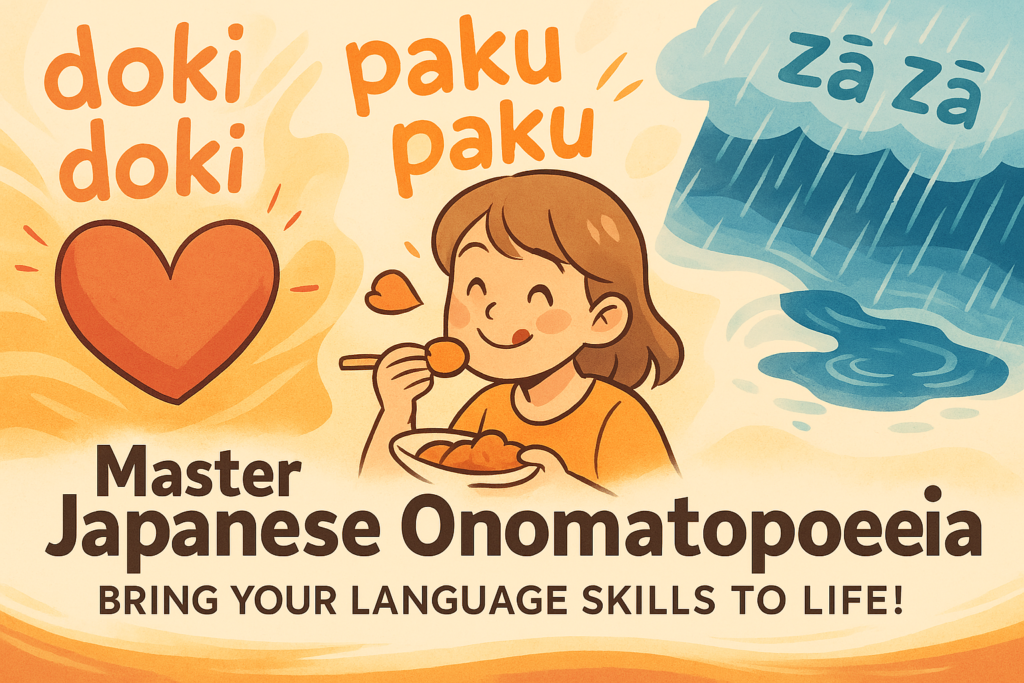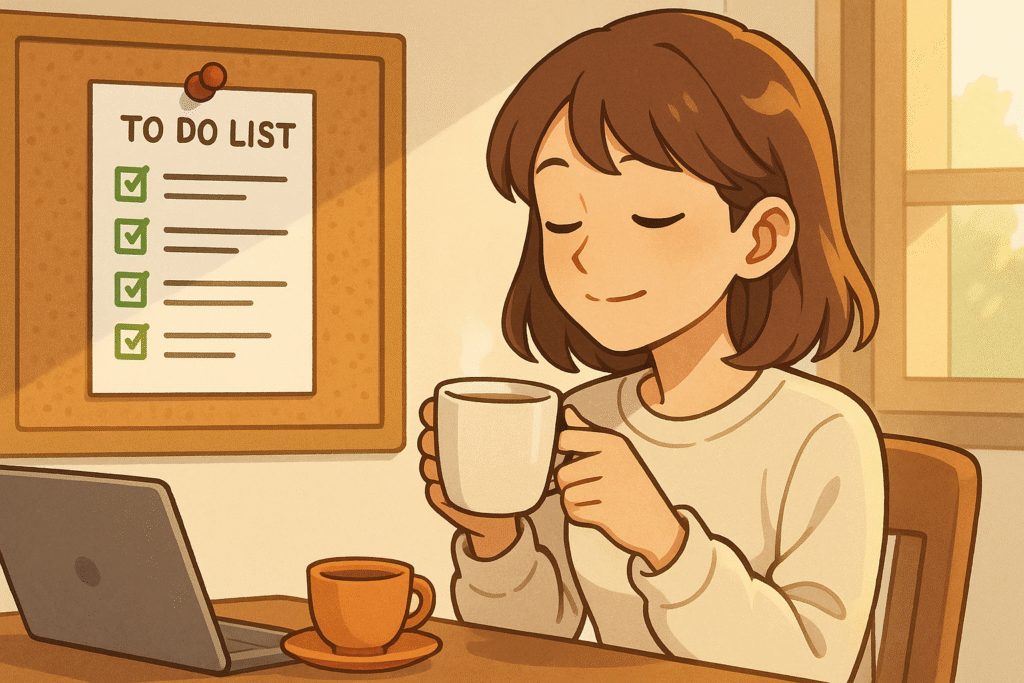Have you ever noticed how manga is filled with sound effects like “ドキドキ” for a beating heart or “ザーザー” for pouring rain? These expressions are called onomatopoeia, and they’re essential for sounding natural in Japanese. Today, I’m excited to share a comprehensive Japanese onomatopoeia list that will transform your language skills from textbook formal to authentically conversational.
What Are Japanese Onomatopoeia?
Japanese onomatopoeia are special words that represent sounds, movements, emotions, and states. Unlike English, which mainly uses onomatopoeia for actual sounds (like “bang” or “meow”), Japanese takes this concept much further with mimetic words describing feelings, states, and movements that don’t actually make sounds.
Japanese onomatopoeia fall into five main categories:
- Giseigo (擬声語) – Animal and human sounds
- Giongo (擬音語) – Sounds from objects and nature
- Gitaigo (擬態語) – Words describing conditions and states
- Giyougo (擬容語) – Words depicting movements and motions
- Gijougo (擬情語) – Words expressing feelings and emotions
Learning these words isn’t just for fun—they’re used constantly in daily Japanese conversation. As I mentioned in my post about how to use the Japanese future tense, mastering expressive elements like onomatopoeia is what separates intermediate learners from those who sound genuinely fluent.
Essential Japanese Onomatopoeia List for Beginners
Let’s start with some everyday onomatopoeia you can immediately incorporate into your speaking:
For Basic Actions
- Walking and Moving
- とことこ (toko-toko) – walking with small steps
- すたすた (suta-suta) – walking briskly
- よちよち (yochi-yochi) – toddling like a baby
- Sleeping
- ぐっすり (gussuri) – sleeping soundly
- うとうと (uto-uto) – nodding off
- Eating
- もぐもぐ (mogu-mogu) – chewing quietly
- ぱくぱく (paku-paku) – eating happily, mouth opening and closing
Want to explore Japan’s culture?
Discover Japan’s rich culture, traditions, and hidden gems with our expertly crafted guides. Get insider tips on travel, food, and history. All for free!
For Expressing Feelings
- Happiness
- わくわく (waku-waku) – excited, thrilled
- うきうき (uki-uki) – cheerful, lighthearted
- Worry/Anxiety
- どきどき (doki-doki) – heart pounding with nervousness
- もやもや (moya-moya) – feeling unsettled or uncertain
Similar to the “eto meaning in Japanese” I discussed in a previous article, these emotional onomatopoeia act as expressive fillers that convey specific feelings instantly.
Weather and Nature Onomatopoeia
Japanese has an especially rich vocabulary for describing natural phenomena:
- Rain
- ざーざー (zā-zā) – heavy rain pouring down
- しとしと (shito-shito) – gentle, quiet rain
- Wind
- びゅーびゅー (byū-byū) – howling wind
- そよそよ (soyo-soyo) – gentle breeze
- Temperature
- ぽかぽか (poka-poka) – comfortably warm
- ひんやり (hin-yari) – refreshingly cool
Just as I explained in my guide about “movie in Japanese,” these descriptive terms help create vivid imagery, whether in conversation or when consuming Japanese media.
How Japanese Onomatopoeia Are Used Grammatically
To use onomatopoeia naturally in sentences, you’ll need to understand their grammatical patterns:
- With と + Verb
- 雨がざーざーと降っています。
- Ame ga zā-zā to futte imasu.
- (It’s raining heavily.)
- With する (to do)
- 心臓がどきどきする。
- Shinzō ga doki-doki suru.
- (My heart is pounding.)
- As Adverbs
- にこにこ笑う (niko-niko warau) – to smile cheerfully
- ゆっくり歩く (yukkuri aruku) – to walk slowly
Japanese onomatopoeia are what make your Japanese sound natural rather than textbook-rigid. For more comprehensive language learning resources, check out our learn Japanese page where you can find free guides to accelerate your learning.
Pro Tips for Mastering Japanese Onomatopoeia
- Listen for patterns: Most Japanese onomatopoeia are repetitive (like doki-doki), making them easier to remember.
- Pay attention to voiced/unvoiced sounds: Compare さらさら (sara-sara, smooth) with ざらざら (zara-zara, rough). The voiced “z” creates a rougher meaning than the unvoiced “s”.
- Read manga: Japanese comics are filled with onomatopoeia and provide visual context.
- Start with a small set: Begin with 10-15 common expressions and gradually expand your repertoire.
The most efficient way to learn Japanese onomatopoeia is through regular exposure and practice. Japanese onomatopoeia are frequently used in everyday conversation, making them essential for natural-sounding Japanese.
Common Questions About Japanese Onomatopoeia
What is the most common Japanese onomatopoeia?
The most common Japanese onomatopoeia in daily conversation is probably どきどき (doki-doki), used to describe a pounding heart or nervousness.
Are Japanese onomatopoeia used in formal settings?
While some onomatopoeia are considered casual, many are perfectly acceptable in formal settings, especially when describing sensations, weather, or actions precisely.
How many Japanese onomatopoeia exist?
There are thousands of Japanese onomatopoeia. A comprehensive Japanese onomatopoeia list would include over 4,500 expressions, making it one of the richest languages for sound symbolism.
How can I practice using onomatopoeia?
The best way to practice is by incorporating them into your daily Japanese conversations, watching anime, reading manga, and listening to native speakers.
Remember, becoming fluent in Japanese isn’t just about learning grammar and vocabulary—it’s about mastering expressive elements like onomatopoeia that bring the language to life. Start with this Japanese onomatopoeia list, and you’ll notice your Japanese becoming more colorful and natural in no time!
For more insights into Japanese language nuances, don’t forget to explore our guides on what watashi means in Japanese and other essential Japanese concepts.
Love Japan? Stay in the Loop!
Get the best of Japan straight to your inbox: language, culture & travel insights!




